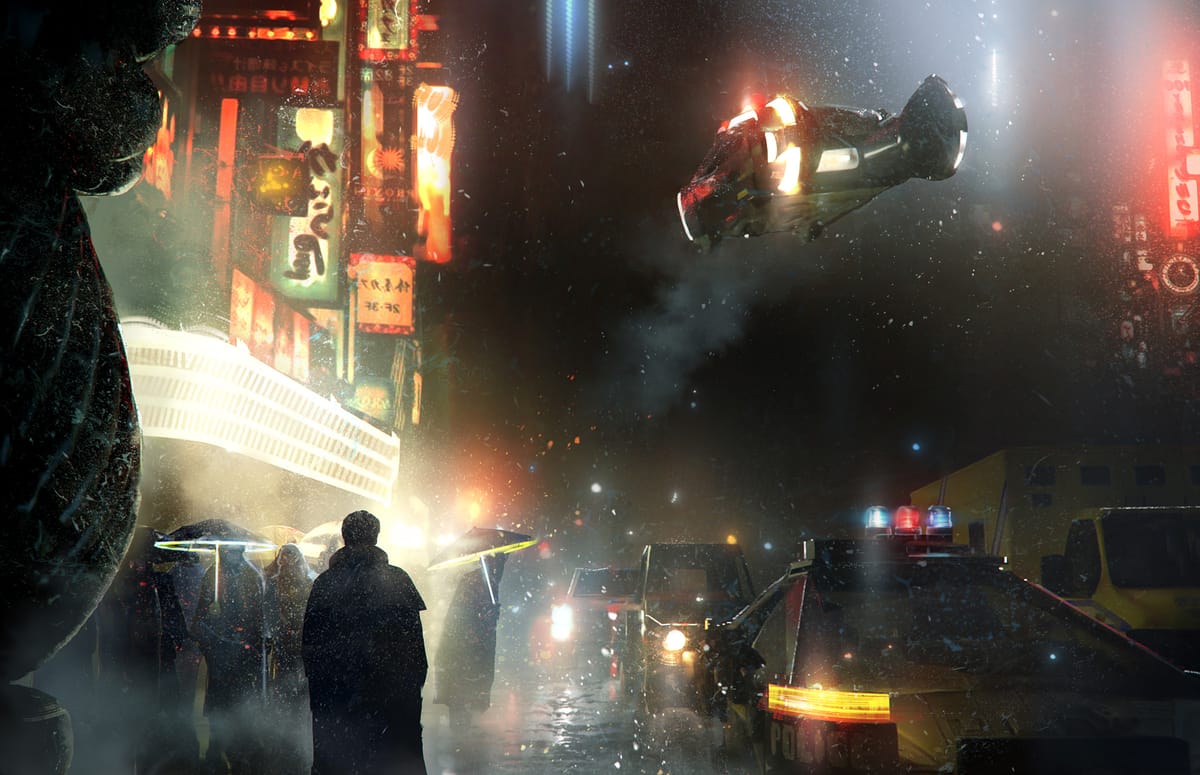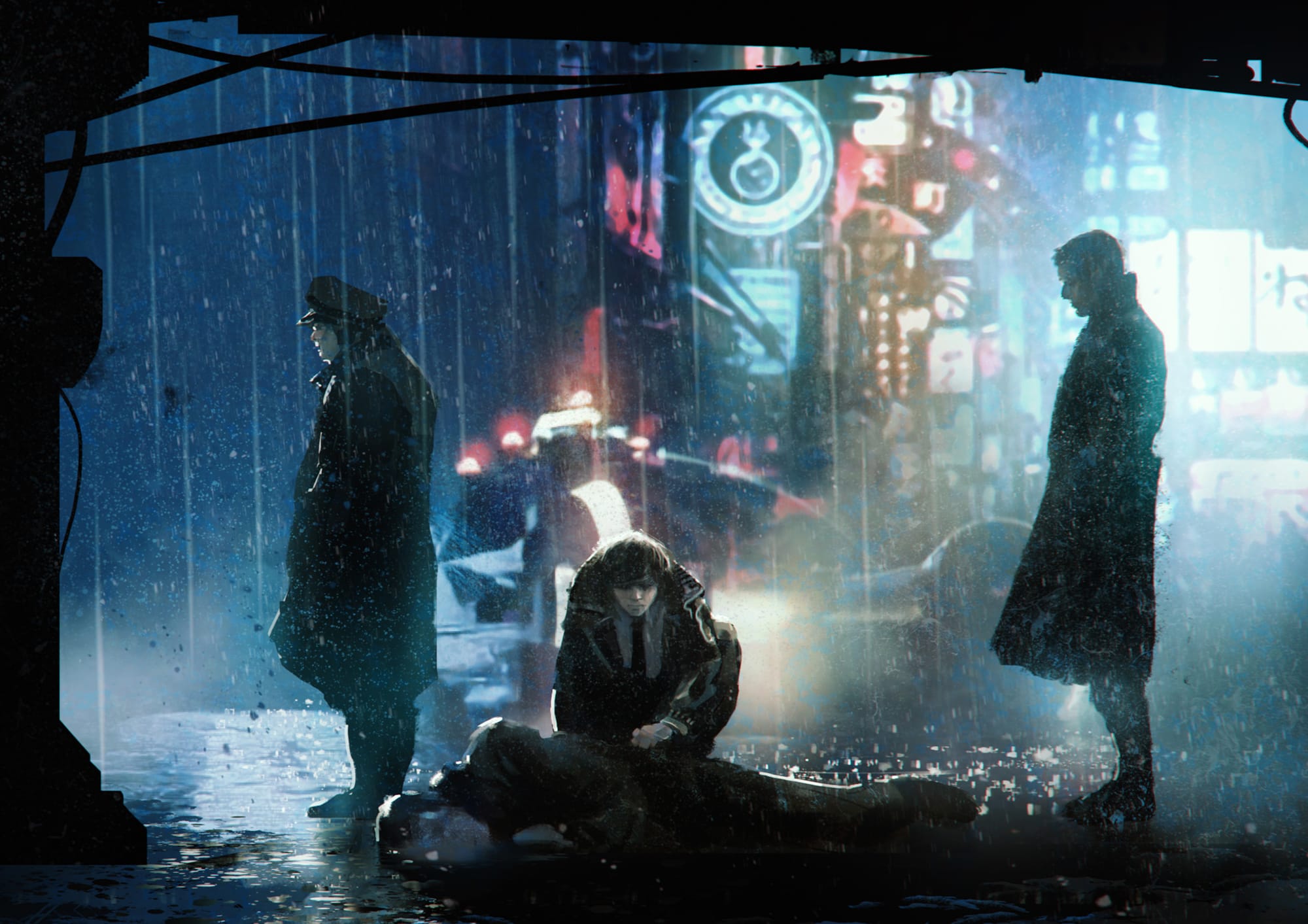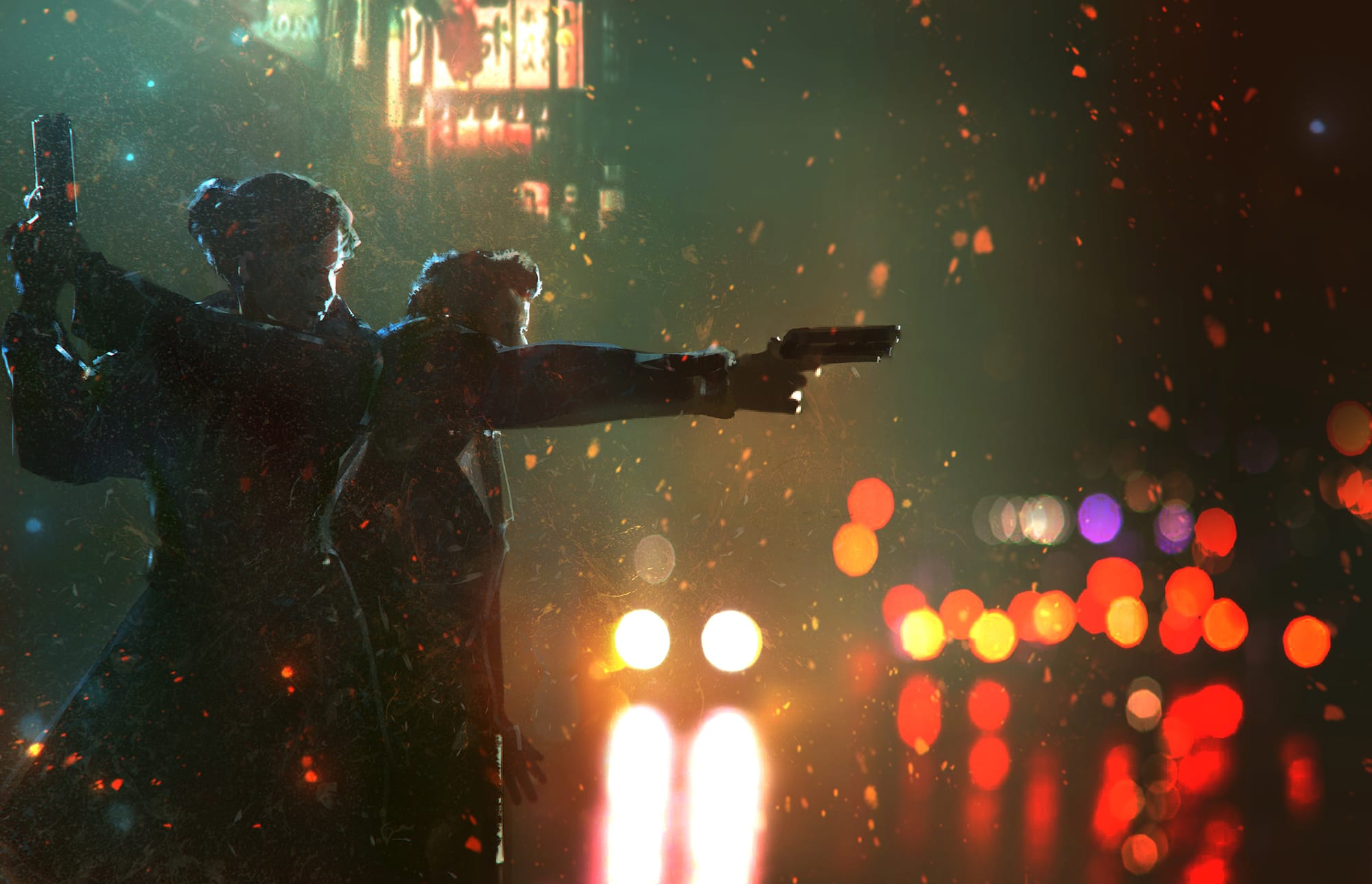
Adapted from Philip K. Dick's Do Androids Dream of Electric Sheep? Ridley Scott’s Blade Runner brought the noir genre into the modern age. Released in 1982 the film’s depiction of a, then, near future Los Angeles -with its crowded neon lit streets a stark contrast to its morally grey, and perpetually rained upon, inhabitants- helped cement the vibe that would dominate science fiction in the 1980s with the rise of cyberpunk.
The original film has long been an inspiration for both roleplaying game players and designers alike and now, 40 years on from its release, Sweden’s Free League Publishing has finally brought it to our tabletops in an adaptation that is remarkably faithful to the tone of its source material. Indeed for Tomas Härenstam, co-founder and CEO of Free League and lead designer of Blade Runner: The Roleplaying Game, the most important, and challenging, aspect of adapting Scott’s series into a tabletop game was replicating that vibe, capturing the films’ themes of alienation and moral ambiguity.
‘Blade Runner, and Blade Runner 2049, pose these difficult moral questions that intrigued me when I saw the films for the first time,’ Härenstam said. ‘Deckard is not your typical hero and Replicants are not your typical villains. That made the story something more than your typical sci-fi action story. I think exploring questions like that is fascinating and when handled right and played in a group of very mature individuals, RPGs can definitely do that.’
The result is an RPG that is less focused on heroic action and more on creating the kind of atmosphere where those themes can be explored. To that end Blade Runner’s core book provides several recommendations on making your sessions more cinematic, from slowing down the pace of the game to more theatrical tricks such as employing low lighting during a session, soundtracking your games with the likes of Vangelis and, especially, making use of props and handouts.
Importantly, of course, the rules must complement this too and the game encourages players to engage with those moral questions and experience their characters’ sense of isolation in such an over-crowded, and over-stimulated, environment.
‘That noir feeling doesn’t really work that well in very large groups, so the game recommends maybe just a single player and the game runner or a small team of two or three max,’ Härenstam said. ‘Contrary to most RPGs, it advocates splitting the party at some points to cover more ground. That also helps to set that mood of the lone investigator that walks the streets.’
Along with eschewing the conventional RPG party dynamic, Blade Runner also doesn’t assume the players are the good guys. They’ll be playing members of the Los Angeles Police Department Rep Detect, or Blade Runner, unit. Like Harrison Ford’s Rick Deckard or Ryan Gosling’s Officer K, their job is to hunt down Replicants, androids ‘virtually indistinguishable from humans’m originally created to serve humanity but now barred from Earth following a failed rebellion
One key feature of the game is how its advancement system mechanises ethical dilemmas. Rather than earning experience points, characters can be rewarded with promotion points for performing their duties well or lose them for acting against their superiors. At the same time, they can earn humanity points for acting with compassion. Specialties and gear are earned through status in the LAPD, but humanity can improve skills, so a player will need to juggle both aspects of their character to unlock their full potential. The goal is to make players feel immersed in the series’ morally gray world.

‘You want to come away having been asked questions and put in positions where the answer is not obvious, where you as a player have to think what the right thing to do here is given the situation you are in,’ Härenstam said. ‘In the films, Blade Runners often find themselves in positions where they don’t follow orders and they do something truer to their hearts and they actually come to see the world in a different way. I want the characters, and to some extent the players themselves, to experience that.’
To build Blade Runner: The Roleplaying Game’s setting Härenstam plumbed all the available source material, drawing not only on the movies but also the video games and the animated short films that were released ahead of Blade Runner: 2049. And, after some debate, this led him to set the game in 2039.
‘Since it’s geographically fairly constrained, if we had been setting it in the exact same year as one of the films, we would have been kind of boxed in and have to follow that very closely.’ he said. ‘Setting it in between the two gave us a bit more creative freedom and made it easier to draw from both films when designing the world.’
The Swedish designer has never been to Los Angeles, so he tapped Genuine Entertainment’s Joe LeFavi to bring his hometown to life and work as the game’s lead setting writer. That detail is important given that Blade Runner games will seldom leave the city.
‘That’s been an interesting challenge, especially compared to our Alien game where you have the entire universe to play with,’ Härenstam said. ‘We want to keep the focus pretty heavily on Los Angeles because we feel that’s such an integral part of the whole franchise. You could potentially go outside, but then it wouldn’t quite feel like Blade Runner anymore.’
Blade Runner: The Roleplaying Game also draws on other noir films and games like Sherlock Holmes: Consulting Detective with its strong focus on solving a core mystery. The game launched last year with the core rulebook and starter set containing Electric Dreams, a case file complete with an abundance of handouts representing security footage, newspaper clippings and suspect profiles from the LAPD database that help bring the adventure to life.
‘You get everything you need in one box,’ Härenstam said. ‘The way the cases are structured it’s fairly easy for even a new game runner. We hope to draw Blade Runner or science fiction fans into this game even though they might not be very familiar with tabletop roleplaying.’
Play time is divided into shifts, with players choosing which leads to pursue, and there are always multiple ways to learn information and progress the plot, something that can often become an issue with games revolving around mysteries.
‘We want to avoid the classic pitfalls of investigation-type roleplaying where if you go to the wrong place, you get stuck and have nowhere to go,’ Härenstam said. ‘Even if you do get stuck, things will kind of happen themselves. There’s always something driving the action forward.’
Those multiple paths include options such as looking up files at the Rep-Detect Unit, hitting up your street assets for help or tailing a suspect. These often are directly linked to handouts. For instance, you can take a picture of a crime scene and then use the Esper machine at the precinct to zoom in and discover new details that might then provide a fresh lead.
After a certain number of shifts have passed, a Countdown event will occur which could be another crime being committed or an NPC showing up asking for help. Either way it provides plenty of ways to keep the game moving forward.

One of the primary pieces of feedback that Härenstam has received from players is that just what make the game’s starter set so useful, the abundance of handouts, also make designing an adventure from scratch intimidating. Whilst the core rulebook includes advice on creating your own case files, tips on how to structure an investigation, develop locations and NPCS, and several tables for generating ideas, it would take a truly ambitious game master to replicate the props that make playing Electric Dreams so immersive.
As a result, Free League will continue to do the work themselves, producing a series of connected case files that can be played as standalone adventures or as an ongoing campaign. Released at the end of 2023, Fiery Angels will have players investigate an attempted break-in at the Wallace Corporation Memory Vaults, opening up new parts of Los Angeles to explore while revisiting many of the locations featured in Electric Dreams from sleek corporate headquarters to shady bars.
‘It’s a challenge because you have to make these case files varied enough while you’re in the same city, but it’s also a fun challenge to use the same geographical locations in different ways and still make them feel fresh,’ Härenstam said. ‘Keeping that local focus in mind is great for campaign play because you learn the city. It works well with the noir feel that you walk the streets as an investigator and you get to know the streets.’
That initial feedback to the game also led Härenstam to develop Replicant Rebellion, a more action-oriented supplement which sees players take on the role of replicants on the run.
‘Playing a Blade Runner felt like the natural starting point, but there are lots of different characters in this universe that could be fun to play,’ Härenstam said. ‘[The rogue Replicant] Roy Batty is the real protagonist of the first film and I think it makes sense to give the option to play the other side fully. Even though it changes the gameplay, I still think it’s going to feel very much like Blade Runner.’
Available in 2024, this sourcebook will give you everything you need to create a cell operating in the replicant underground, conducting operations that are a mix of corporate sabotage and helping other replicants avoid detection. While the rules for combat and chase scenes will stay the same, Replicant Rebellion will feature new player character archetypes which will largely be shadow versions of the various types of Blade Runners such as enforcer or analyst. The book will also provide a detailed history of the replicant underground and include half a dozen operations for characters to take on.
‘The operations that we are including in Replicant Rebellion are fairly short —- the idea is to have them designed as one-shots so you can play them in a single night, but of course you can tie them together into longer stories and campaigns,’ Härenstam said. ‘We think the game will benefit from having another mode that is a bit easier to improvise and that doesn’t require that much preparation.’
Replicant Rebellion will also be more conducive to larger groups, with five to six players working together rather than the cap of four placed on the core game. It will also rely less on handouts and, with its emphasis on infiltrating and fighting against corporations, have a more traditional cyberpunk feel.
‘A Blade Runner is in such a morally complicated position but being on the Replicant Rebellion side might be more straightforward,’ Härenstam said. ‘It’s less grey and just feels like doing good, but that definitely doesn’t mean there won’t be any moral issues at stake.’

Building rules for both sides also creates opportunities to develop new game dynamics. Most of the characters in a Replicant Rebellion game are, naturally, expected to be Replicants, but you will also have the option to potentially play a human sympathizer. It also opens the game up to different groups of PCs coming into conflict.
‘You could build a campaign where you have people on both sides,’ Härenstam said. ‘Even if you’re playing Blade Runners, there are so many options for not doing what you’re supposed to do and helping the other side that the player vs. player potential is already there. You could have two separate groups, one Blade Runners and one the Replicant Rebellion side, run side by side like a joint double campaign. That would require a bit of work, so I’m not sure we’ll do that as an official product, but it’s definitely something game runners can build.’
Härenstam has designed some lighter games like the recently released Dragonbane, a reimagining of the 1982 Swedish classic fantasy TTRPG Drakar och Demoner that requires little prep time and, in Free League’s own words, leans towards ‘mirth and mayhem’. But he’s mostly focused on darker science fiction with titles like Alien - The Roleplaying Game, based on Blade Runner director Ridley Scott’s Alien films, and the post-apocalyptic Mutant: Year Zero.
‘Some days you just want something light and easy and fun, but other days you prefer to dig deeper into something a bit heavier,’ Härenstam said. ‘Sci-fi and fantasy are called escapism, and that’s true to a point, but for me they’ve always been something more. They are a way to see our world through a different lens.’
Speculative fiction is also a way of processing shifting realities, and one of the reasons that Blade Runner has remained so influential 40 years after its release is how prophetic its vision of a ruined earth ravaged by hyper-capitalism proved to be.
‘When watching Blade Runner in the ‘80s, this kind of climate change and artificial intelligence were purely fantastical, far away concepts,’ Härenstam said.
‘Now we’re not exactly there, but some days I feel like the game is a bit too close to reality for my comfort. But the flip side of that is that it makes these questions even more current and important to deal with right now.’
Blade Runner - The Roleplaying Game Core Rules and Starter Set are out now
published by Free League
This feature originally appeared in Wyrd Science Vol.1, Issue 5 (Dec '23)

